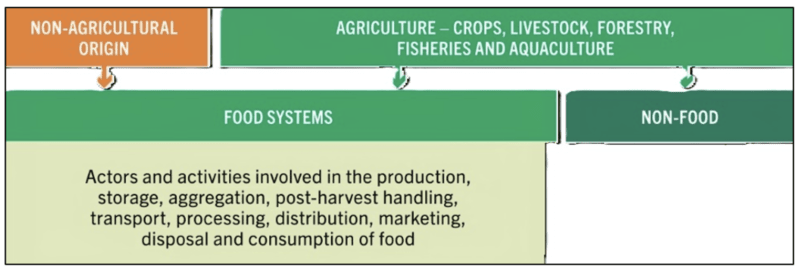GS Paper III
News Excerpt:
Recently, The State of Food and Agriculture Report 2023, was published by the Food and Agriculture Organization (FAO).
About the report:
- The theme for 2023 was "Revealing the true cost of food to transform agrifood systems".

- The report introduces the concept of hidden costs and benefits of agrifood systems. These costs and benefits could be environmental or social. This would be the first quantification attempt of such data.
- The report proposes a new approach i.e. True Cost Accounting (TCA), to assess them.
- These interactions of agrifood systems with the environment, economy, nutrition, health, and society are ultimately connected to the Sustainable Development Goals (SDGs) and thus are relevant in helping us achieve the 2030 goals.
- SDGs related to it:
- SDG 1 (No Poverty)
- SDG 2 (Zero Hunger)
- SDG 3 (Good Health and Well-being)
- SDG 6 (Clean Water and Sanitation)
- SDG 7 (Affordable and Clean Energy)
- SDG 12 (Responsible Production and Consumption)
- SDG 13 (Climate Action)
- SDG 14 ( Life below Water)
- SDG 15 (Life on Earth)
Findings of the report:
- Unhealthy Diets:
-
- They are high in ultra-processed foods, fats, and sugars.
- They cause obesity and non-communicable diseases and also lower the productivity of the workforce.
- These diets were seen to be particularly elevated in high- and upper-middle-income countries.
- Overall, our current agrifood systems impose hidden costs equivalent to at least $10 trillion a year, representing almost 10% of the global Gross Domestic Product (GDP).
- Consumption of highly processed foods was seen to be increasing in peri-urban and rural areas of some countries, driven by urbanization, changes in lifestyle and employment profiles of both women and men, as well as increasing commuting times.
- The diffusion of processed foods across the rural-urban scene was similar and quite extensive for both high- and low-food-budget countries.
- On average, the share of total processed foods and food away from home was 29% in high-food-budget countries and 25% in low-food-budget countries.
- While the consumption of processed food is already advanced in Asia and Latin America, it is spreading quickly in Africa as well.
- Penetration of highly processed foods was also observed in rural areas, even those 1-2 hours or more from a city or town.
- Food Security:
-
- The prevalence of moderate or severe food insecurity at the global level remained unchanged for the second year in a row.
- About 29.6% of the global population were moderately or severely food insecure in 2022, of which about 11.3% of people in the world were severely food insecure.
- It is projected that almost 600 million people will be chronically undernourished in 2030.
- Among the nine South Asian countries, India had the third highest prevalence of undernourishment (233.9 million) in the total population, after Afghanistan and Pakistan.
- The share of undernourished people in India, however, had come down from 21.4% of the population in 2004-06 to 16.6 in 2020-22.
- Low-income countries were the hardest hit by hidden costs of agrifood systems, which represented more than a quarter of their GDP, as opposed to less than 12% in middle-income countries and less than 8% in high-income countries.
Way Forward:
- The report highlights the need for decision-makers to systematically account for the hidden costs and benefits of agrifood systems in order to guide structural change. This change will help us deliver affordable healthy diets to all while also respecting environmental limits.
- The transformation of agri-food systems is needed to address issues like the climate crisis, poverty, inequality, and food insecurity.
- This mainstreaming of agrifood systems assessment is critical to FAO’s vision of transitioning to more sustainable agrifood systems for better production, better nutrition, a better environment, and a better life for all.
Mains PYQ
Q. Elaborate the scope and significance of the food processing industry in India. (UPSC 2022)
Q. What are the main bottlenecks in upstream and downstream process of marketing of agricultural products in India? (UPSC 2022)
